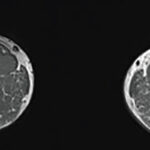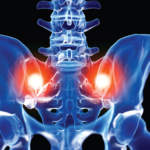In individuals without radiographic knee osteoarthritis (OA), Chang et al. investigated whether magnetic resonance imaging (MRI) defined knee OA at baseline was associated with incident radiographic and symptomatic disease during up to 11 years of follow-up. The researchers found the two current MRI definitions of knee OA may not adequately predict the development of radiographic and symptomatic disease.
Chronic Back Pain & axSpA
Maksymowych et al. assessed the frequency of axial spondyloarthritis (axSpA) according to extra-articular presentation and human leukocyte antigen B27 (HLA-B27) status and sought to identify features that distinguish patients with axSpA from those with non-specific back pain. Their data support recommendations that patients with chronic back pain and extra-articular features related to axSpA be screened for axSpA with MRI and referred to a rheumatologist.

Do NSAIDs Mask MRI Findings in Patients with Axial Spondyloarthritis?
Research suggests the use of non-steroidal anti-inflammatory drugs may mask the amount of sacroiliac joint inflammation found on MRI in patients with axial spondyloarthritis.

A Primer on Imaging in Myositis
In medicine, as in advertising, pictures can be worth a thousand words. From arthritis to vasculitis, imaging studies have been variably employed to aid in the diagnosis, treatment, risk stratification and prognostication of patients with rheumatic and musculoskeletal disorders. The same holds true with the idiopathic inflammatory myopathies (IIM), in which the clinical utility is…
Sacroiliitis on MRI: axSpA or Another Cause?
Magnetic resonance imaging (MRI) is the gold standard imaging modality for the detection of sacroiliitis, a hallmark of axial spondyloarthritis (axSpA). However, the specificity of MRI for axSpA has been questioned. Renson et al. found that structural MRI-detected SI joint lesions are frequently seen in healthy individuals.

Imaging of Axial Psoriatic Arthritis
The axial phenotype of psoriatic arthritis (axPsA) is an excellent example of a major controversy in rheumatology that has become the focus of attention because of the emergence of new therapies with different mechanisms of action for alleviating joint inflammation. It was first described in 1961 but, until recently, it has largely remained under the…

In the Bones: RheumMadness 2022 False Positive MRI in Axial SpA
Spondyloarthropathy (SpA) can be difficult to diagnose, with rheumatologists sometimes relying on classification criteria designed for clinical trials. Research examines how the use of MRIs affects the finding of bone marrow edema and the diagnosis of axial SpA.
According to MRI, Ultrasound Guidance Does Not Improve Treat-to-Target in RA
NEW YORK (Reuters Health)—Ultrasound guidance does not improve the effectiveness of treat-to-target therapy in rheumatoid arthritis (RA), new findings confirm. “Incorporating ultrasound information in treatment decisions did not lead to reduced MRI inflammation or less structural damage compared with a conventional treatment strategy,” Dr. Ulf Sundin of Diakonhjemmet Hospital, Oslo, and colleagues write in Rheumatology….

MRI-Guided Therapy Offers No Improvement Over Conventional Treat to Target for RA
New research does not support the use of a magnetic resonance imaging (MRI)-guided strategy for treating RA patients. The study found that among RA patients in remission, an MRI-guided treat-to-target strategy compared with a conventional treat-to-target strategy did not result in improved disease activity remission rates or reduced radiographic progression…
Silent Cardiac Impairment in SLE
Drug-naive, new-onset SLE patients, even those with inactive disease, are likely to have silent cardiac impairment, according to a new study by Guo et al. Cardiac involvement is the leading cause of death in patients with lupus, and the estimates of cardiac impairment in SLE range from 31–70%. Cardiac impairment can remain unrecognized until after autopsy. These researchers investigated the use of cardiac MRI to explore early warning signs of silent cardiac involvement in SLE and determine treatment timing…